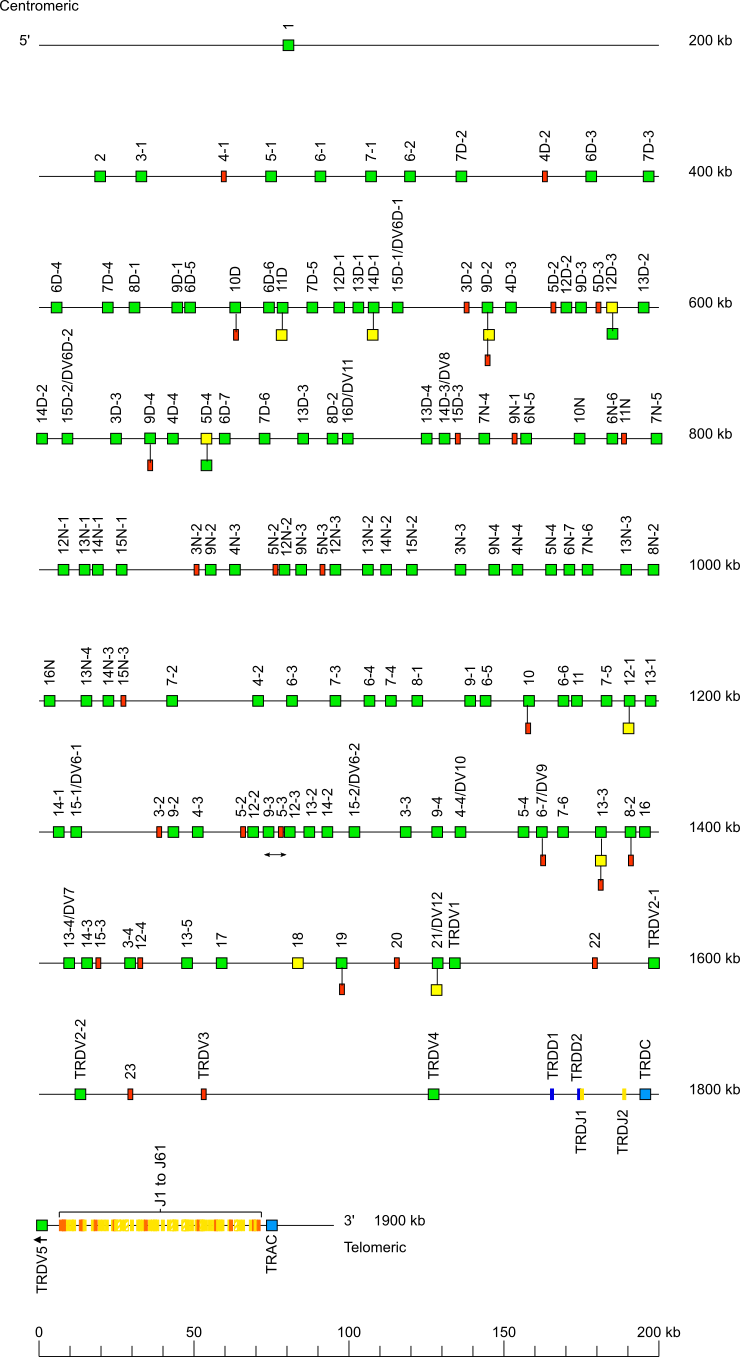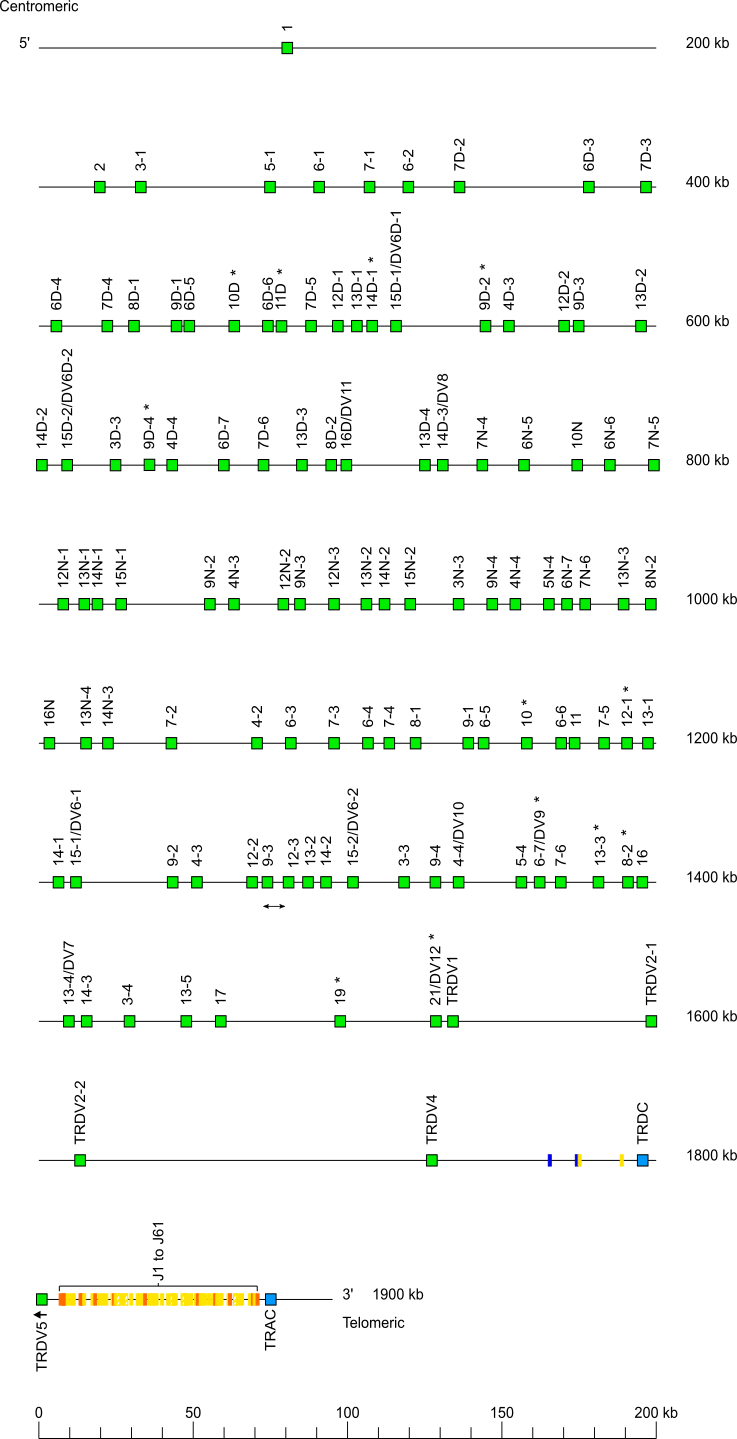IMGT Repertoire (IG and TR)
Locus representation: house mouse (Mus musculus) TRA locus on chromosome 14 (14C2) at 19.7cM
UPDATE: 30/04/2003.
TRAV and TRDV genes are designated by a number for the subgroup followed, whenever there are
several genes belonging to the same subgroup, by a hyphen and a number for their relative localization.
Numbers increase from 5' to 3' in the locus.
TRAV15-2/DV6-2 and TRAV15D-2/DV6D-2 were assigned to the TRAV15 subgroup on the basis of sequence alignment,
although they have not been found yet rearranged to TRAJ genes (Bosc, N., IMGT comment, 01/08/2002).
Eight new pseudogenes identified by Inyoul Lee, Jared Roach and Leroy Hood
(e-mail 08/06/2001 to M.-P. Lefranc) have been added to the map. Four of
them belong to known subgroups: TRAV3D-2, TRAV15D-3, TRAV3-2 and TRAV15-3.
The four others are single members of new subgroups: TRAV18, TRAV22, TRAV23
and TRDV3.
TRAJ genes are designated by a number according to their localization from 3' to 5'. Ortholog genes in human and mouse have the same numbers. No TRAJ10 has been identified in the mouse.
In the TRA locus of Mus musculus C57BL/6J, there is an insertion of 300 kb between TRAV15D-3 and TRAV7-2, that corresponds to a triplication of part of the TRAV genes. The triplicated genes are indicated with the letter N in their name. They comprise 34 TRAV genes (of which 27 are functional and 7 are pseudogene).
House mouse (Mus musculus) TRA locus on chromosome 14 (14C2) at 19.7cM
The orientation of the house mouse (Mus musculus) TRA locus on chromosome 14 (14C2) at 19.7cM is forward (FWD).

Legend:
Colors are according to IMGT color menu for genes.
The boxes representing the genes are not to scale. Exons are not shown.
A double slash // indicates a gap in genome assembly. Distances in bp (base pair) or in kb (kilobase) associated with a double slash are taken
into account in the length of the lines and included in the numbers displayed at the right end of the lines.
The blue full line and the blue broken line below the map represent two parts of the locus which are duplicated.
The TRAV genes of the proximal V-CLUSTER are designated by a
number for the subgroup, followed by a hyphen and a number for the localization from 3' to 5' in the locus.
Double arrows indicate insertion/deletion polymorphisms.
The TRAV genes of the distal duplicated V-CLUSTER are designated by the same numbers as the corresponding
genes in the proximal V-CLUSTER, with the letter D added.
Single arrow under TRDV5 shows the polarity is opposite to that of the TRD
D-J-C-CLUSTER.
• OR10G3 (olfactory receptor family 10 subfamily G member 3) (5' borne) has been identified 40 kb upstream of TRAV1 in C57BL/6J (F), the most 5' gene in the locus. However, this borne still needs to be confirmed in others species.
• DAD1 (defender agaisnt cell death) (3' borne) has been identified 11 kb downstream of TRAC (F), the most 3' gene in the locus.
Locus representation with only the functional genes: house mouse (Mus musculus) TRA locus on chromosome 14 (14C2) at 19.7cM

* When needed, indicate the presence of allele(s) with another functionality: see above house mouse (Mus musculus) TRA locus on chromosome 14 (14C2) at 19.7cM
Zoom for TRAJ genes

TRAV genes
- [1] Lee, I.Y. et al., unpublished (1998).
- [2] Wilson R.K. et al., unpublished (2006).
- [3] Wilson et al., Genomics, 13, 1198-1208 (1992).
- [4] Koop et al., Genomics 13, 1209-1230 (1992).
- [5] Seto, D. et al., Genomics, 20, 258-266 (1994).
- [6] Azuara, V. et al., Eur. J. Immunol., 28, 3456-3467 (1998).
- [7] Lee, I.Y. et al., unpublished (1998).
- [8] Chien, Y.H. et al., Nature, 330, 24-31 (1987).
- [9] Chien, Y.H. et al., Nature, 330, 24-31 (1987).
- [10] Toda, M. et al., J. Mol. Biol., 202, 219-231 (1988).
- [11] Rowen, L. et al., unpublished (1997).
- [12] Iwashima, M. et al., Proc. Natl. Acad. Sci. USA., 85, 8161-8165 (1988).
- [13] Bosc, N., Scaviner, D., Folch, G., Ginestoux, C., Giudicelli, V. and Lefranc, M.-P. IMGT overview: the mouse T cell receptor alpha TRA genes. 19th International Mouse Genome Conference (IMGC), November 5-8, 2005, Strasbourg, France (2005).
 .
.
- Gene table: Mouse (Mus musculus) TRAV
- Gene table: Mouse (Mus musculus) TRAJ
- Gene table: Mouse (Mus musculus) TRAC
- Gene table: Mouse (Mus musculus) TRDV
- Gene table: Mouse (Mus musculus) TRDD
- Gene table: Mouse (Mus musculus) TRDJ
- Gene table: Mouse (Mus musculus) TRDC
- Potential germline repertoire: Mouse (Mus musculus) TRAV and TRAJ genes on chromosome 14
- Potential germline repertoire: Mouse (Mus musculus) TRDV, TRDD and TRDJ genes on chromosome 14
- Created:
- 04/04/2001
- Last updated:
- 22/09/2023
- Authors:
- Elodie Foulquier, Nathalie Bosc, Géraldine Folch, Viviane Nguefack Ngoune and Guilhem Zeitoun
